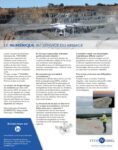Recent advancements in India’s air defense have marked a decisive turning point in regional dynamics. These improvements are the result of a clever integration of local and foreign technologies. The success of this strategy is reflected in impressive capabilities on the ground.
The remarkable performance of defense systems, combined with precision strikes, reveals a significantly enhanced military potential. At the heart of this prowess is the Akash missile system, designed to protect critical infrastructures. This missile, with its mobile configuration, offers essential flexibility on the battlefield. Furthermore, widely deployed UAVs (drones), whether domestic or international, have considerably strengthened Indian offensive operations. The key to this capability lies in the efficient integration of technologies, overcoming the challenges posed by rapidly evolving systems.

In a world where geopolitical tensions are intensifying, the necessity for an effective air shield is no longer in question. India, in particular, has made significant progress thanks to the Sindoor Operation. This operation involves the use of national defense technologies, combined with an innovative strategy to protect its airspace. The combination of a robust air defense system with precision weaponry helps illustrate how India is transforming its defense.
At the heart of this operation are systems such as the Akash missile, a mobile defense platform that allows for quick responses in the event of an attack. Developed locally, the Akash is a perfect example of how India relies on its own resources to build a solid defense. In addition, advanced warning systems and drones enhance surveillance and intervention capabilities. The integration of these technologies reflects a broader approach aimed at reducing reliance on imported armaments.
Table des matières
ToggleWhat are the main strengths of Indian air defense?
Several elements enhance the effectiveness of the Indian air shield, with domestic technologies playing a key role. One of the major strengths lies in the development and integration of defense systems that include satellite-guided technologies, such as the NavIC navigation system. This service offers unparalleled accuracy, essential for surgical strikes against enemy targets.
Meanwhile, India has established a unique combination of drones and aircraft capable of providing intelligence and reconnaissance capabilities. The use of drones, both domestic and imported, in concrete missions allows for mapping enemy movements while reducing the risk to human forces. This aspect plays a crucial role in rapidly assessing and responding to potential threats.
The BrahMos missiles, for example, bolster this framework with their supersonic speed and ability to strike at impressive distances. Rated as one of the best cruise missiles in the world, they illustrate India’s technological ascent and its determination to maintain a balance of power in the region. This type of technology, blending national approaches with strategic partnerships, consolidates the foundations of an almost impenetrable air defense.
How does India integrate national defense systems?
One of the major challenges India faces is the integration of various defense systems, including both domestic and foreign components. This process is complex; however, the success of the Sindoor Operation is an example of it. The systems are not only complementary, but their effectiveness is enhanced through this fusion. Launch platforms like the Akash are integrated with more advanced intelligence systems, allowing for real-time coordination of military response.
Establishing a robust command and control network is crucial in this context. This system consists of secure communication channels that allow for the rapid transmission of data regarding aerial threats. This level of integration is also the result of a phased development, where each component is tested and optimized based on the results of earlier phases.
Furthermore, the research and development (R&D) sector is promoted by the government to stimulate innovation and reduce dependence on foreign technologies. The business model is primarily driven by local companies collaborating with military institutions. This partnership not only enriches the defense ecosystem but also contributes to the overall technological advancement of India. Recent collaborations in the field of military drones perfectly align with these goals.
What challenges do defense systems face?
Despite advancements, Indian air defense is not without difficulties. The need for increased indigenization is a major issue. Although India has developed effective systems, the country still faces external dependency issues regarding certain technological components. For instance, the purchase of specific electronic parts or advanced technologies from abroad remains common, even though the goal is to achieve complete autonomy.
Another challenge lies in managing bureaucracy. Many defense programs suffer from administrative delays, resulting in slow acquisition and implementation processes. Regulatory bodies need to evolve rapidly to adapt defense policy to modern needs and avoid misunderstandings that could delay crucial projects.
The issue of data security is also paramount. In an era where cyber threats are multiplying, protecting command and control systems must be a priority to prevent sensitive information from being compromised. Adopted models must include robust cyber security protocols, ensuring that defense infrastructures withstand intrusion attempts.
What innovations can further strengthen air defense?
Technological advancements offer a wide range of opportunities to improve defense operations. Research into innovations such as laser defense systems or satellite surveillance technologies could lead to the implementation of even more effective solutions. One of the future projects is the development of interconnected sensor networks that will provide real-time aerial coverage.
Countries like Israel have already demonstrated the success of these approaches. For example, the Iron Beam system that integrates air defense lasers represents a possibility for India to adopt a similar approach. This would allow for the detection and neutralization of threats with great precision while minimizing the operating costs of conventional missile systems.
The search for strategic partnerships with other countries possessing advanced technologies is also essential. These alliances can contribute to knowledge exchange and co-creation of new systems. In addition to fostering innovation, this can help India establish a competitive presence in the global arms market.
Continuous updating of the research infrastructure is equally crucial. By supporting private initiatives through incentives and funding programs, India can accelerate the development of innovative solutions while building a sustainable innovation ecosystem.
How does the Sindoor Operation reflect India’s strategic positioning?
The implementation of the Sindoor Operation illustrates how India wants to position its defense on the global chessboard. By developing local defense capabilities, India aims to establish a balanced power equation in the face of regional threats. The success of the operation is not only a testament to modern technology but also a symbol of strategic determination.
In the context of international relations, this autonomy reinforces India’s discourse and stature on the global stage. With growing security crises in the region, having an advanced alert and protection system becomes crucial for its sovereignty. Demonstrating its capabilities also helps deter potential aggressions.
On the other hand, the development of technologies like the BrahMos embodies the evolution of military doctrines. Both tactically and operationally, this shows preparedness to manage modern conflicts. To this end, continuous efforts in research are vital to staying ahead of security challenges.
Collaborative efforts with other nations to strengthen defense systems and strong government support for innovation in the defense sector are necessary for future success. By consolidating these techniques, India enhances its status as a regional power.
This unique dynamic of technological integration and strategic awareness contributes to managing various elements of national security while even supporting defense export projects.
Aerial power is redefining the strategic landscape, and India, with the Sindoor Operation, shows that it is ready to meet the challenge.
























